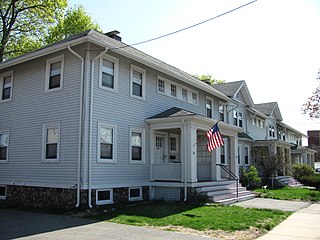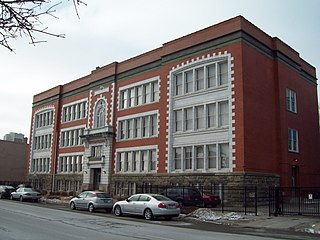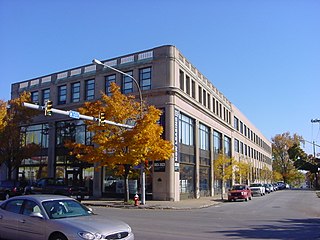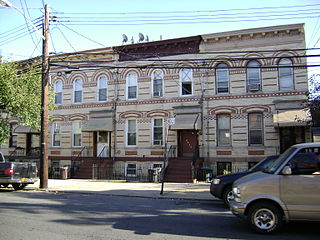
The building at 38–48 Richardson Avenue is a historic residential rowhouse in Wakefield, Massachusetts. Built c. 1912, is believed to be one of the oldest rowhouses in the town. They were built by Solon O. Richardson, Jr., on a portion of his family's estate. The building was listed on the National Register of Historic Places in 1989.

The buildings at 35–37 Richardson Avenue are historic rowhouses in Wakefield, Massachusetts. These two rowhouses, built c. 1912–15, are among the earliest apartment blocks built in the town. They were built by Solon O. Richardson, Jr. on a portion of his estate. The buildings were listed on the National Register of Historic Places in 1989.

Rowhouses at 303-327 East North Avenue is a group of historic rowhouses located at Baltimore, Maryland, United States. The row houses at 303-317 and 319-327 East North Avenue consists of two groups of brick Victorian row houses that rest on high masonry foundations and are four stories high which includes a mansard roof. These two groups of row houses are some of the most elaborately decorated rows that were constructed in Baltimore in the late 19th century outside of Mount Vernon.

William Dorsheimer House is a historic home located at Buffalo in Erie County, New York, that was listed on the National Register of Historic Places in 1980.

33-61 Emerson Place Row is a set of historic rowhouses located at Buffalo in Erie County, New York. It is one of a rare surviving group of speculative multi-unit frame residences designed to resemble rowhouses in the city of Buffalo. It was built in 1893, by land dealer and speculator Benjamin B. Rice. The seven unit row features decorative shingle sheathing and two-story bow windows.
17-21 Emerson Place Row was a set of historic rowhouses located at Buffalo in Erie County, New York. It was built in 1900, by land dealer and speculator George C. Rice and demolished in the early 2000s due to neglect.

Bruce—Briggs Brick Block is a historic rowhouse block located at Lancaster in Erie County, New York. It is a mid-19th century brick structure unique in Western New York, which incorporates both Greek Revival and Italianate style decorative details. The rowhouses were built for George Bruce, one of the early settlers of Lancaster.

Delaware Avenue Methodist Episcopal Church, also known as Asbury-Delaware Methodist Church, is a historic Methodist Episcopal Church located at Buffalo in Erie County, New York. It was constructed in two phases between 1871 and 1876 and is a distinct example of High Victorian Gothic ecclesiastical architecture. In 2006, the structure became home to Righteous Babe Records, and known as "The Church" or "Babeville".

Richmond Avenue Methodist-Episcopal Church, also known as Richmond Avenue United Methodist Church, is a historic Methodist Episcopal Church located at Buffalo in Erie County, New York. It consists of two structures: a rectilinear Chapel structure, which dates to 1885–1891, and a larger Temple structure dating to 1887–1898. Both structures are two and a half stories set on a raised basement story, with two three-story towers. They are built of ashlar Medina sandstone. It is now home to the Upper West Side Arts Center.

Laurel and Michigan Avenues Row was a set of historic rowhouses located at Buffalo in Erie County, New York. It was a set of speculative multi-unit frame residences designed to resemble rowhouses. The set of nine frame, two story rowhouses were built about 1880. They were demolished in 1997.

Parke Apartments, also known as Park Lane Condominium, is a historic apartment building located at Buffalo in Erie County, New York. It was designed and built in 1924-1925 by the H.L. Stevens & Company and is an early 20th-century high class apartment building modestly styled in the Second Renaissance Revival mode. It is a ten-story, concrete framed masonry building built of cream colored brick with light stone detail in a "T" shaped layout. Also on the property is a two-story former carriage house. It was converted from apartments to condominiums in 1977.

School 13, also known as Boys Vocational High School and Buffalo Alternative High School, is a historic school building located at Buffalo in Erie County, New York. It was built about 1915, and is a three-story, steel framed building sheathed in brick and terra cotta with Beaux-Arts style design elements. The "T"-shaped building housed administrative offices, classrooms, a gymnasium, swimming pool, and two-story auditorium. The building housed a school until 2003.

Rev. J. Edward Nash Sr. House is a historic home located at Buffalo in Erie County, New York. The house was constructed in 1892 and is in the Queen Anne style. It was home to Rev. J. Edward Nash Sr. (1868–1957), a prominent leader in Buffalo's African American community. He served as pastor at the Michigan Avenue Baptist Church from 1892 to 1953. Rev. Nash purchased the frame, two flat home in 1925 and his wife remained in the home until 1987. The house underwent exterior restoration in 2002-2003 and has been designated the Nash House Museum.

Packard Motor Car Showroom and Storage Facility is a historic automobile showroom located at Buffalo in Erie County, New York. It is a three-story, reinforced concrete frame structure with restrained Neo-classical detailing. It was designed by Albert Kahn in about 1926 and served as a Packard dealership for 30 years.

Parkside West Historic District is a national historic district located at Buffalo in Erie County, New York. The district is architecturally and historically significant for its association with the 1876 Parks and Parkways Plan for the city of Buffalo developed by Frederick Law Olmsted in 1876. It consists of 137 contributing structures developed primarily from 1923 to 1940, as a middle class residential neighborhood. The district largely contains single-family dwellings, built in a variety of popular architectural styles, and located along the irregular and curvilinear street pattern developed by Olmsted. They include homes along Nottingham Terrace and Middlesex Road, and segments of Meadow Road, Lincoln Parkway, Delaware Avenue, and Amherst Street. The district is located to the north of Buffalo's Delaware Park.

Wollenberg Grain and Seed Elevator was a historic grain and seed elevator located at Buffalo in Erie County, New York. It was built in 1912 and remained in service until 1987. It was notable as the sole surviving example of a wooden or so-called "country style" elevator. It was built in the style of the earliest elevators dating to the 1840s and had a capacity of 25,000 bushels.

Cooper Avenue Row Historic District is a national historic district in Glendale, Queens, New York. It includes seven contributing buildings built in 1915. They consist of two story, flat front brick rowhouse dwellings with one apartment per floor. They are constructed of yellow brick with burnt orange brick details. They feature some of Glendale's most striking and elaborate brickwork.

Manhattan Avenue–West 120th–123rd Streets Historic District is a national historic district in Harlem in New York City. It consists of 113 contributing residential rowhouses built between 1886 and 1896. The buildings are three story brownstone and brick rowhouses over raised basements in the Queen Anne, Romanesque, and Neo-Grec styles.

Vera and the Olga are two historic rowhouse blocks located at Indianapolis, Indiana. They were built in 1901, and are two-story, ten unit, red brick rows on a courtyard. Each building has a hipped roof and each unit is three bays wide. The buildings feature projecting bay windows and front porches.






















